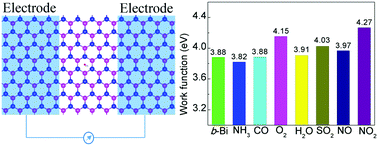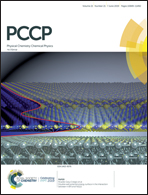Gas sensing properties of buckled bismuthene predicted by first-principles calculations†
Abstract
First-principles calculations are used to study the structural, electronic, transport and optical properties of buckled bismuthene with the adsorption of various gas molecules such as CO, O2, H2O, NH3, SO2, NO and NO2. By considering the van der Waals interactions between the gas molecules and buckled bismuthene, we find that the buckled bismuthene shows superior gas sensing performance to other 2D materials such as graphene and MoS2. The adsorption of CO, O2, H2O and NH3 molecules is physisorption, whereas SO2, NO and NO2 are chemisorbed on the buckled bismuthene with large charge transfer and strong adsorption energy. After adsorption, charges are transferred from buckled bismuthene to the molecules and the quantum conductance is changed by the adsorbed molecules. Furthermore, the work function of buckled bismuthene is changed with the adsorption of different molecules. Our results show that the electronic, transport and optical properties of buckled bismuthene are sensitive to the adsorption of gas molecules, which suggests that buckled bismuthene holds great potential for application in gas sensors.



 Please wait while we load your content...
Please wait while we load your content...